Updated: October 2025
Woke up with a stiff neck and wondering how to get rid of neck pain from sleeping wrong? As you reach over to turn off your alarm clock, you feel it immediately: sharp pain shooting down your neck. It’s a common ailment that most of us experience, but the discomfort can make it difficult to get through the day. It can make it difficult to turn your head, sit or stand for long periods of time, and even impact your ability to concentrate. Additionally, neck pain can lead to headaches, shoulder pain, and other related issues.
Fortunately, there are several ways to alleviate neck pain and prevent it from occurring in the first place — including investing in a good pillow and ergonomic chair, doing stretches and when needed, a trip to the physiotherapist!
What causes neck pain during sleep?
A sore neck can be a real pain, and can be hard to target the cause of it. More often than not, the pain and stiffness you feel in your neck when you wake up is the result of sleeping in one position for too long without moving (the human body is meant to move around, even in sleep). Sometimes, the pain is so excruciating that it can feel as if you’ve injured yourself while sleeping. Fortunately, this is often not the case.
The culprit of neck pain can be attributed to various factors including:
- Lack of support: Sleeping on a pillow or mattress that doesn’t provide adequate support can result in a sore neck from sleeping. Over time, this can lead to chronic pain and stiffness in the neck and body, making it difficult to get a good night’s sleep.
- Sleep position: Sleeping in a position that places the neck in an awkward or strained position for a prolonged period will lead to muscle stiffness and soreness.
- Stress: When you are under stress your muscles tend to tense up even while you sleep and your sleep is often disrupted, which can result in waking up with neck pain.
- Preexisting injury: If you have an injury or condition that affects your neck, such as whiplash, arthritis, or a herniated disc, you may be more prone to experiencing neck pain during sleep.
How long does neck pain last from sleeping wrong?
The duration of how long the pain will last will vary from person to person, depending on the severity of the pain, the cause of the pain, and the individual’s overall health. In most cases, a stiff neck will resolve itself within a few days.
However, if the pain is severe and continues for more than a few days consider making a physiotherapy appointment. In the meantime, there are several things you can do to help relieve the pain.
What to do when you sleep on your neck wrong?
Waking up with a sore neck can ruin your day before it begins. Whatever the cause, there’s no reason to suffer. Here are a few things you can do to ease the pain in your neck and restore your range of motion.
Keep moving
Try to move your neck as much as you can. This might sound counterintuitive, but gentle movement can help to increase blood flow and reduce stiffness. The most important principle here is to keep the movements pain-free – don’t move your neck too far if it hurts. Here’s a simple exercise you can do anywhere:
- Begin by gently tilting your head from side to side
- Lift your head up and look up at the ceiling, then look down and tuck your chin to your chest
- Slowly rotate your head to the right and hold for a few seconds, then rotate to the left and hold for a few seconds
You’ll need to hold each stretch for 15-20 seconds, repeating 2-3 times to each side, and 2-3 times a day for optimal results. Remember to move your neck gently and slowly to avoid further injury or pain.
Hot and cold
Hot and cold therapy can help reduce inflammation and provide relief to sore muscles. It’s important to note that using the wrong temperature can actually make things worse. Applying ice will help reduce inflammation such as swelling and bruising, while heat will help the muscles relax and promote blood flow to the area. If there doesn’t appear to be an injury and there isn’t any swelling or excessive warmth in the area, heat is the best option. Otherwise, if those symptoms are present it’s best to apply ice to reduce the swelling.
Below are some ways to apply heat and ice to your sore neck:
Heat therapy:
- Apply a heating pad (electric pad or microwavable hot pack) or a hot towel to your neck for 15-20 minutes
- Take a warm shower or bath
Cold therapy:
- Use an ice pack wrapped in a damp towel and apply it to your neck for 10-15 minutes
- Wrap a bag of frozen vegetables or ice in a damp towel and apply it to your neck
Remember to never apply heat or ice directly to the skin, as it can cause burns or further injury. Always wrap the hot or cold source in a towel or cloth before applying it to your skin.
Massage the area
Massaging the area can help to relieve tension and reduce stiffness. Here are some tips on how to massage the area:
- Use your hands to gently massage the affected area. Push into the tight spots and hold the pressure for 60-90 seconds (or as long as needed), triggering the muscles to release. You will know when the muscles start to relax because the tenderness begins to decrease. Continue to press until the tenderness no longer lessens. This means the muscle is no longer relaxing. Poke around again and find another tender spot.
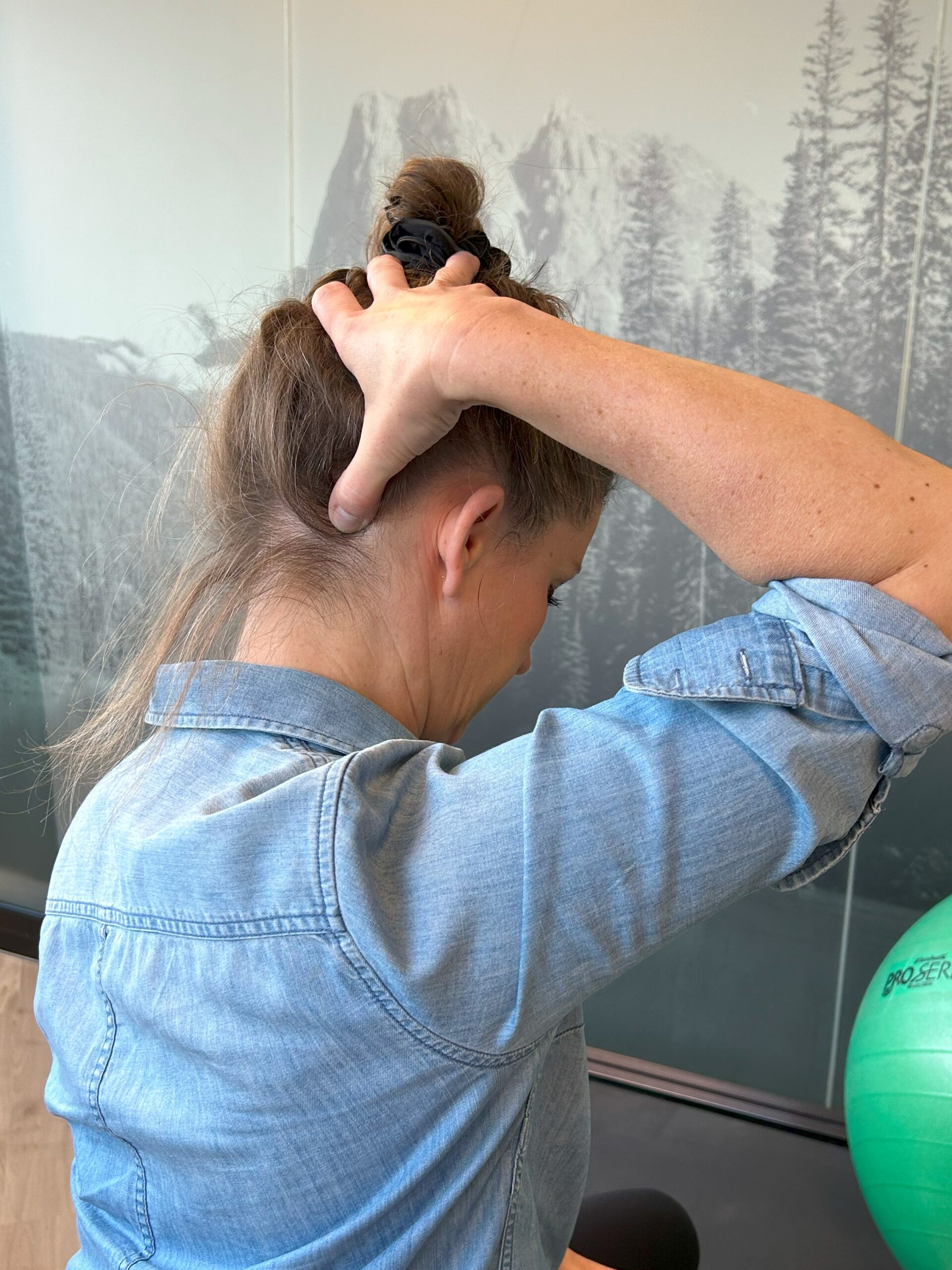
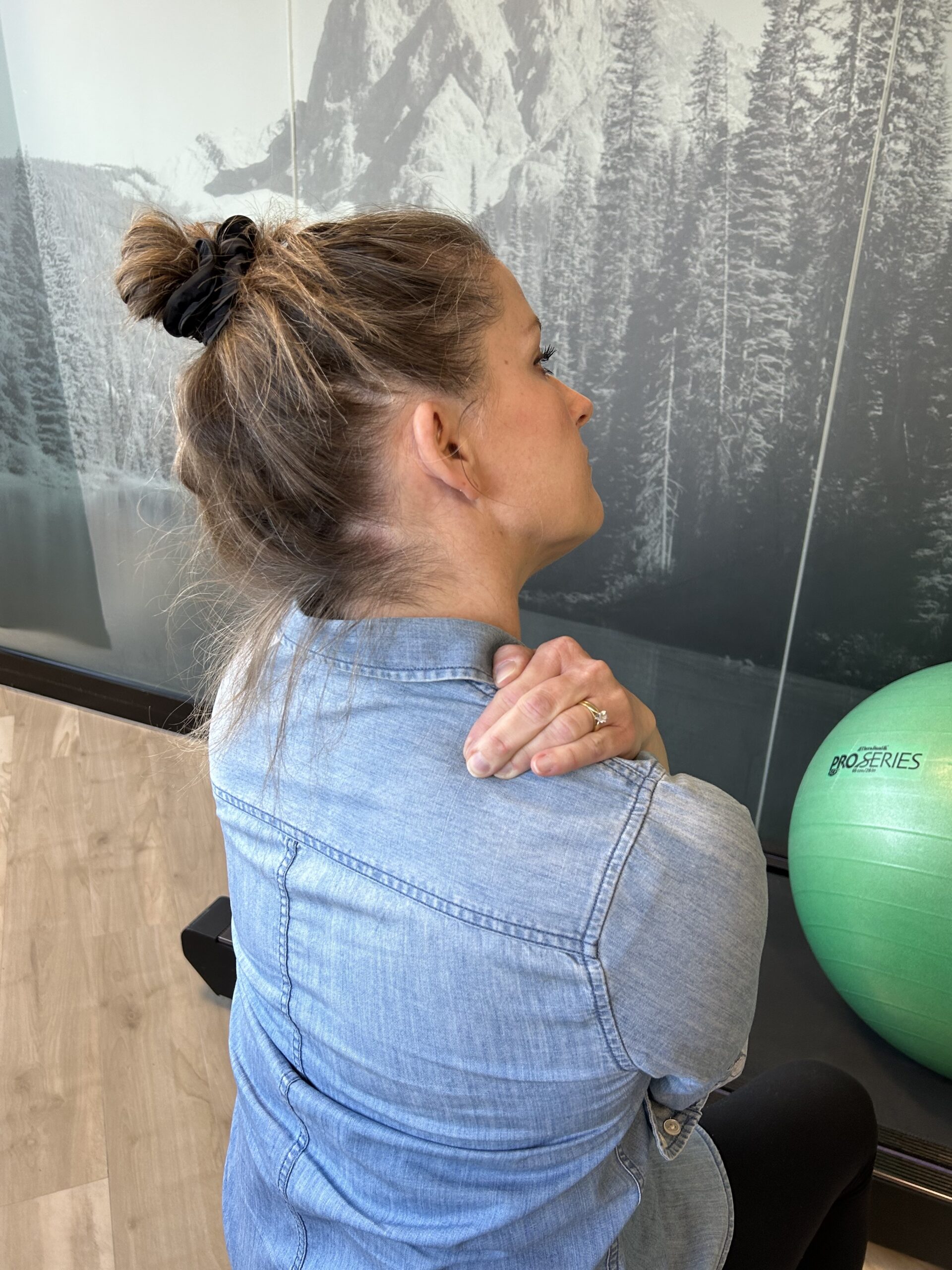
- Use a foam roller or tennis ball to gently roll your neck, which can help release tension in your muscles and increase blood flow. Lie on your back and place the ball or roller at the base of your skull, just slightly below the bony bump. Slowly nod your head up and down 10 times, then turn your head left and right 10 times and finally, you can make small circles clockwise and counterclockwise, also 10 times each. You can also turn your head to one side and make circles with your head turned right or left.
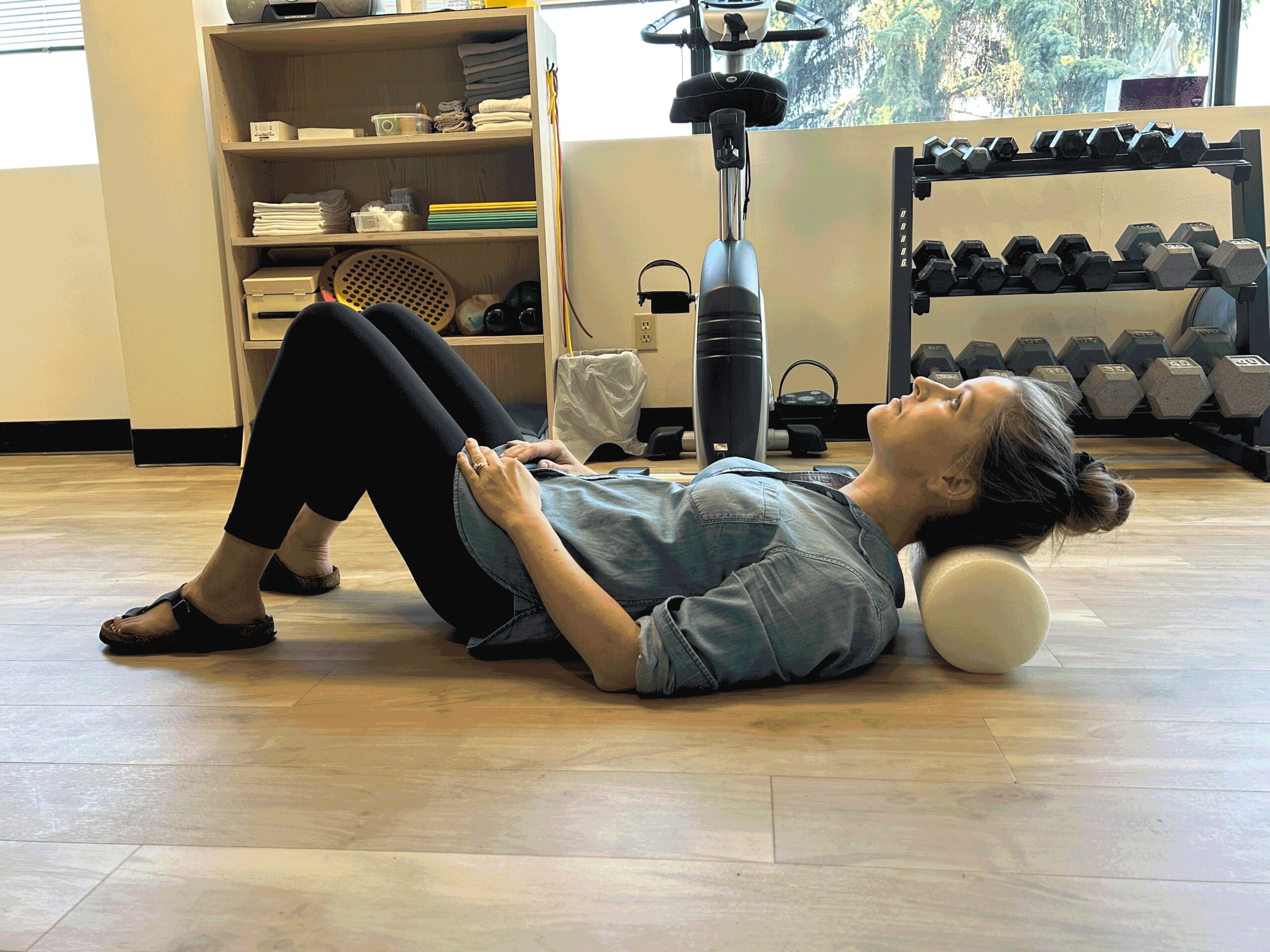
- You can also try the same technique as above, when you are using your hands. Place the ball or roller at the base of the neck, just beneath the bony prominence. Nod or turn your head and find the tender spot on the muscle and hold until the tenderness dissipates just as described above
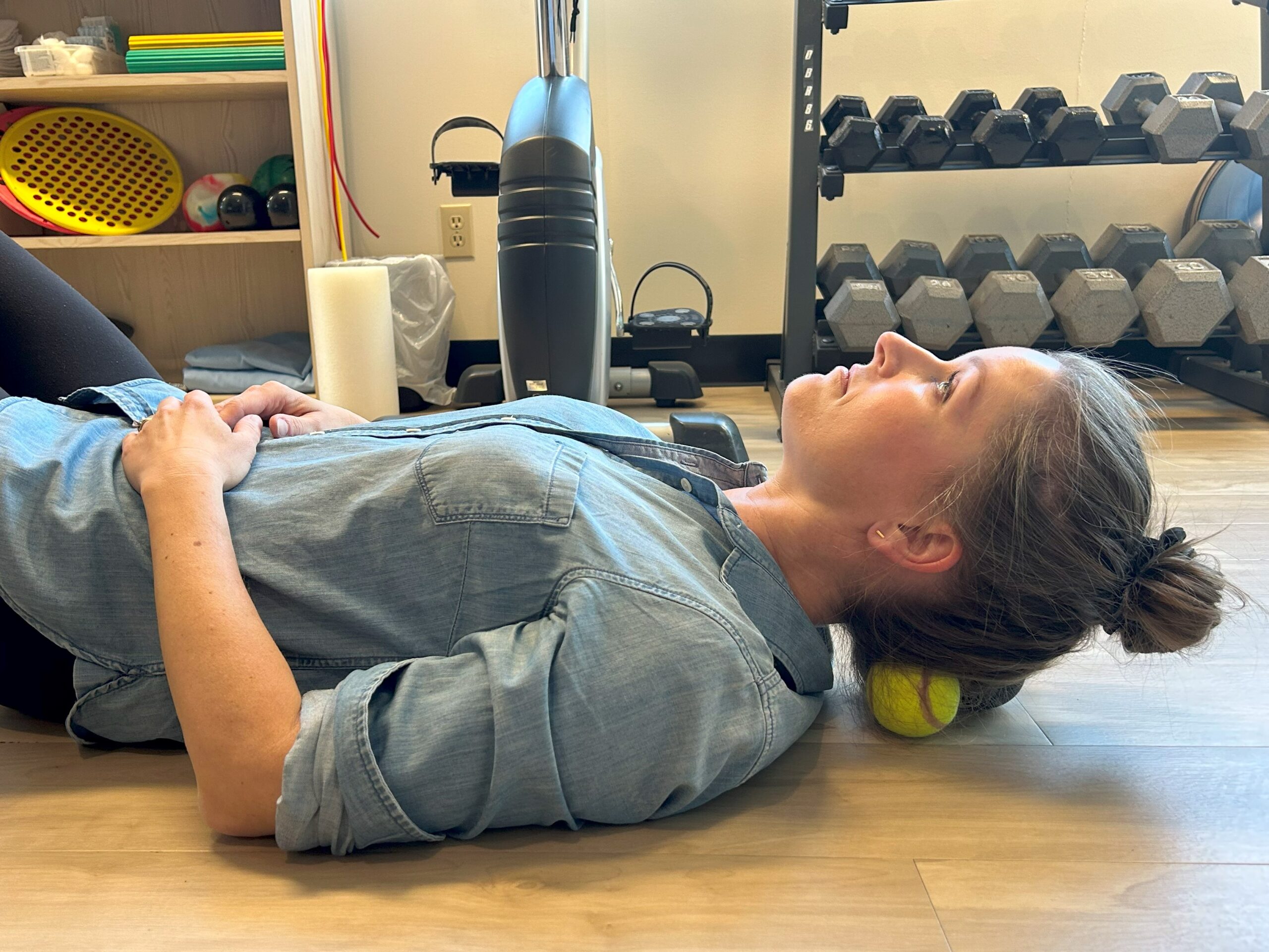
- Remember to never apply too much pressure or force, and stop if you experience any excessive pain.
Use a muscle relaxant or anti-inflammatory medication
If the above methods do not provide relief, you can use a muscle relaxant or anti-inflammatory medication. These can help to reduce inflammation, relax your muscles and provide relief from pain. However, it is important to speak with your physician before taking any medication and to take them only as directed.
See a physiotherapist
Neck pain and stiffness generally subside on their own, but if it doesn’t go away in a few days — or gets worse — it’s time to get physiotherapy. Don’t wait it out if you have any other symptoms — like headaches, pins-and-needles or numbness and tingling down your arms — as you may have a neck injury that would benefit from treatment sooner than later.
7 Ways To Prevent Neck Pain From Sleeping
Waking up with neck pain can put a damper on your day before it even starts. Whether it’s due to an awkward sleeping position, the wrong pillow, poor posture, or chronic pain, there are steps you can take to prevent this discomfort. In this guide, we’ll provide you with effective strategies to help prevent waking up with neck pain.
1. Practice good posture
One of the most effective ways to prevent neck pain is to practice good posture. Throughout the day, make a conscious effort to check in on your posture and notice how you are holding your body. Slouching or hunching forward increases the weight your neck has to support, causing your neck muscles to strain. Instead, keep your shoulders back and relaxed, chin tucked in, and spine straight (no slouching).
Practicing good posture helps to alleviate neck pain by reducing strain on the muscles and joints in the neck and shoulders. When you maintain good posture, your neck and spine are in neutral alignment, meaning that the weight of your head is evenly distributed over your neck and shoulders.
2. Consider your sleeping position
Your sleep position can have a significant impact on your neck and spine’s alignment, which can, in turn, affect the occurrence of neck pain.
Sleeping on your stomach can be problematic because it puts your neck in an awkward position for prolonged periods. This position can cause your neck to twist, putting strain on the muscles, ligaments, and joints, leading to joint and muscle stiffness.
It is recommended to sleep on your back or side to maintain proper spinal alignment and prevent neck pain. When you sleep on your back, your head, neck, and spine should be in a neutral position, with the weight of your neck and head evenly distributed across your pillow. If you have back problems, or experience pain while sleeping on your back, consider placing a pillow under your knees.
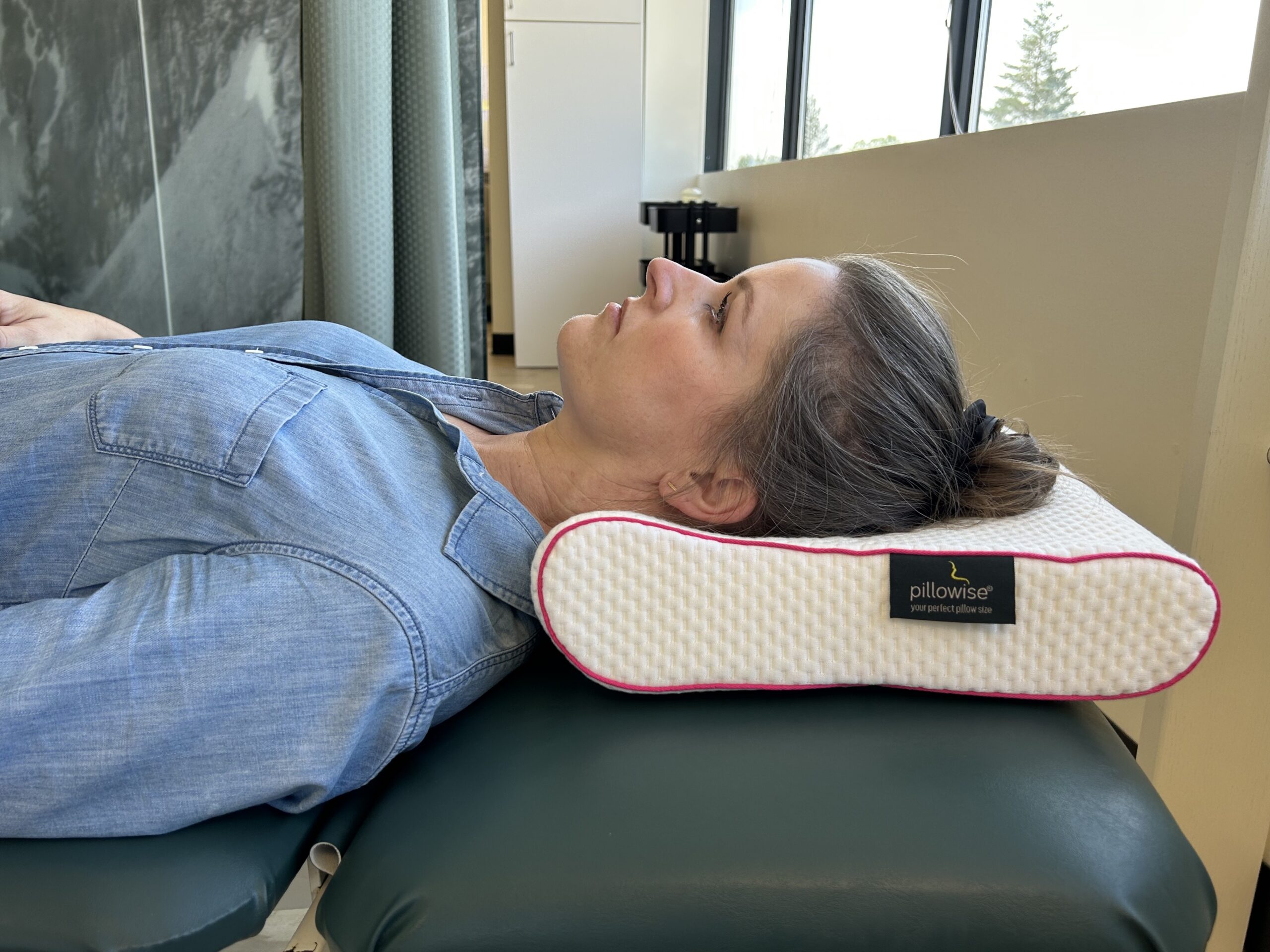
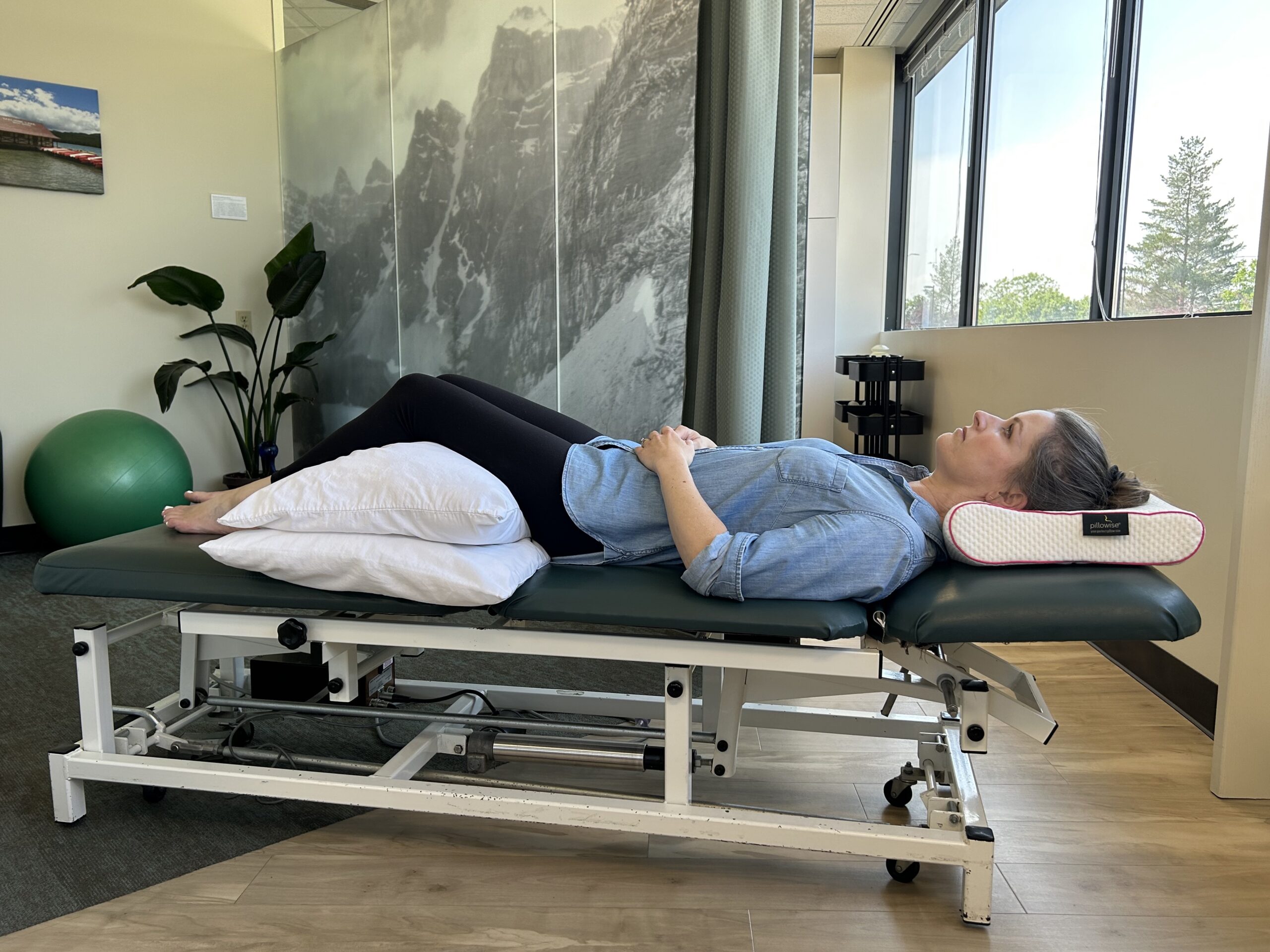
When you sleep on your side, it is essential to use a supportive pillow to keep your head and neck in alignment with your spine, facing forward and not tilted or rotated to one side. Keep your knees only slightly bent with a pillow between your knees and ankles to avoid the spine and pelvis from tilting and twisting.
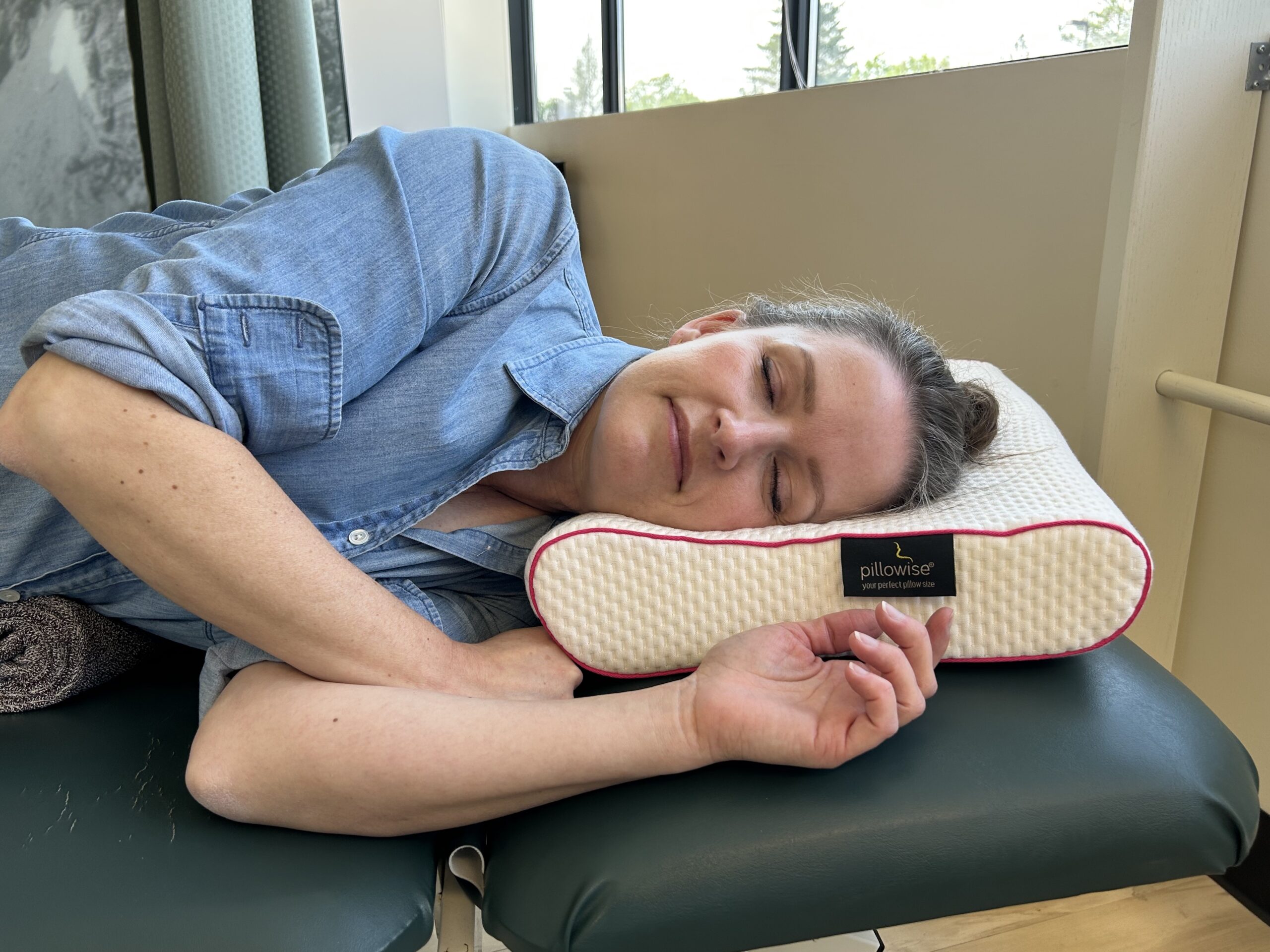

3. Invest in proper support
Investing in proper support for your neck and spine is crucial to prevent waking up with neck pain. Both your pillow and mattress should be supportive and allow your body to maintain its natural curves.
A supportive pillow helps maintain the natural curvature of your neck and spine, preventing painful muscle tension and joint stiffness. When you sleep you want to maintain the good posture we referred to earlier where your spine is straight, shoulders are relaxed and back, your chin is slightly tucked in and your head is facing forward. A good pillow will help you accommodate this position. We offer customized fitting for pillows through Pillowise that will fit you properly and take into account your sleeping position and bed firmness. Contact us to book a customized pillow fitting.
Sleeping with a pillow that is too thick or too thin or doesn’t support your neck, can cause your neck to twist and bend, which will lead to stiffness, discomfort and even pain. Often neck contoured pillows or water pillows can be very useful as they support both your neck and head in the correct position. You may have to try different brands and sizes to ensure that the pillow is the right fit for you.
Similarly, a supportive mattress is important for preventing and alleviating neck pain. A mattress that is too soft or too firm can cause your spine to bend and twist, leading to discomfort and poor sleep quality.
When investing in a pillow and mattress it’s important to consider your individual needs to ensure optimal support and comfort. Check out what our physiotherapists recommend:
Pillows:
- Consider purchasing a neck contoured pillow, either foam or water-filled that fulfills the stated requirements above.
- Our physiotherapists recommend Pillowise, a fully customizable pillow available at our clinic.
- We measure your shoulder width, neck length, and circumference, while also taking into account your bed firmness and preferred sleeping position.
- Make sure to take a few pillows home and try them out before making a final decision.
Mattresses:
- Avoid mattresses that are too soft or too stiff.
- Opt for a mattress that adjusts to your body shape and helps keep your spine straight.
- Consider a memory foam top.
Remember, the right pillow and mattress can make a huge impact on your overall health and well-being. Don’t rush the decision and take the time to find the right one for you.
4. Improve your workspace
If you work at a desk or spend hours sitting, it’s essential that you set up an ergonomic workstation. Here are some ways to improve your workspace and reduce the risk of neck pain:
- Your chair should be adjusted to ensure that your feet are flat on the floor, and your knees are level with your hips.
- The backrest of your chair should support your lower back’s natural curve, and your shoulders should be relaxed. Your back should be up against the lumbar support of your backrest.
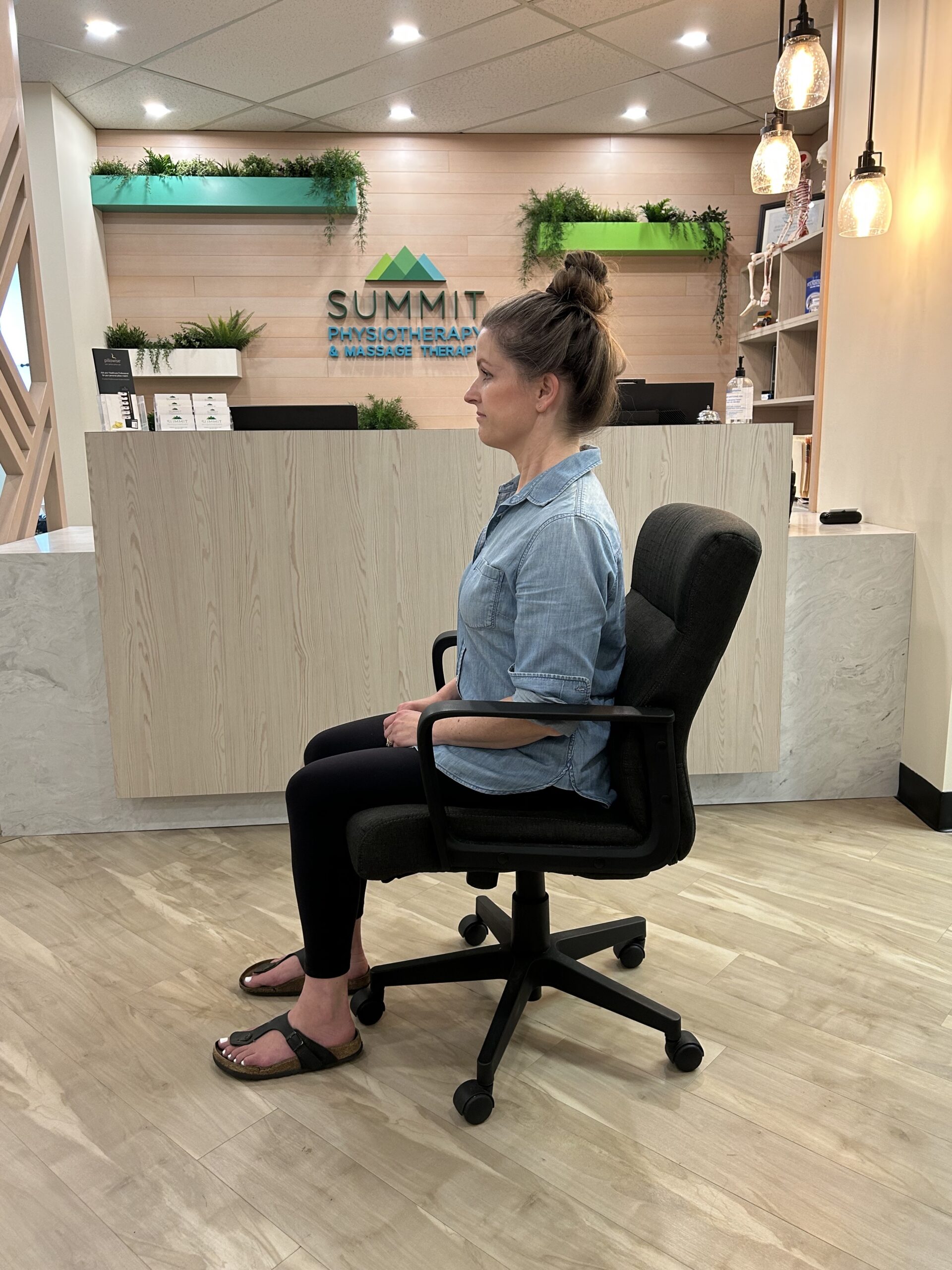
- Your elbows should be bent to 90 degrees and tucked into your sides when using your keyboard and mouse. A keyboard tray may be required to help with this.
- Adjust your computer monitor to be positioned at eye level to prevent slouching.
- Take regular breaks to stretch and move around.
- Use a headset or speakerphone when talking on the phone to avoid cradling the phone between your neck and shoulder.
5. Regular exercise
Incorporating exercise into your daily routine can help keep your neck healthy and pain-free. Exercises that increase your core strength so that you can sit for extended periods of time with proper posture are essential, such as front and side planks, bridges and bent-over rows. Other great exercises to help strengthen the muscles that support proper shoulder position are dumbbell rows, prone flies and reverse flies. These muscles support the neck and help maintain good posture, which can reduce the stress on the neck muscles and prevent pain. Stretches such as neck rotations, side bending and chin tucks can help loosen up tight muscles and joints, reducing the risk of injury and pain.
Front Plank
Assume the starting position by lying on your stomach, propping yourself up on your elbows with your toes touching the ground. Engage your core muscles and raise your pelvis off the floor, relying solely on your elbows and toes for support. Ensure your body forms a straight line from your ears and shoulders down to your ankles. Hold 10-30 seconds, and repeat 5 times. Repeat 1-2 times per day. Don’t hold your breath, keep breathing!
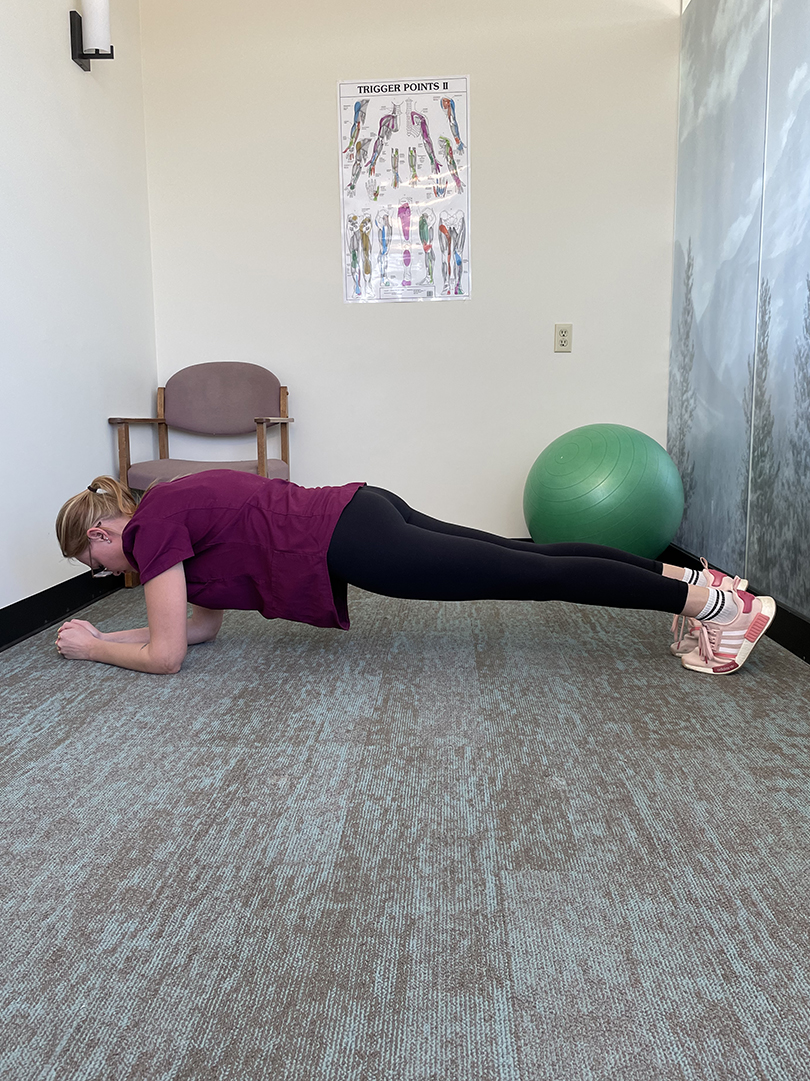
Bent Over Rows
Stand with your feet shoulder-width apart, holding a barbell, dumbbells, or any other suitable weight in front of you with an overhand grip (palms facing down). Hinge at your hips and bend your knees slightly, maintaining a straight back and engaging your core muscles. Your upper body should be at approximately a 45-degree angle to the floor.
Keep your elbows close to your body as you lift the weight, and avoid excessive swinging or arching of your back. Once the weight reaches your lower chest or upper abdomen, pause briefly, and feel the contraction in your back muscles. Lower the weight back down in a controlled manner to the starting position, fully extending your arms. Do 3 sets of 10 repetitions, 1-2 times per day.
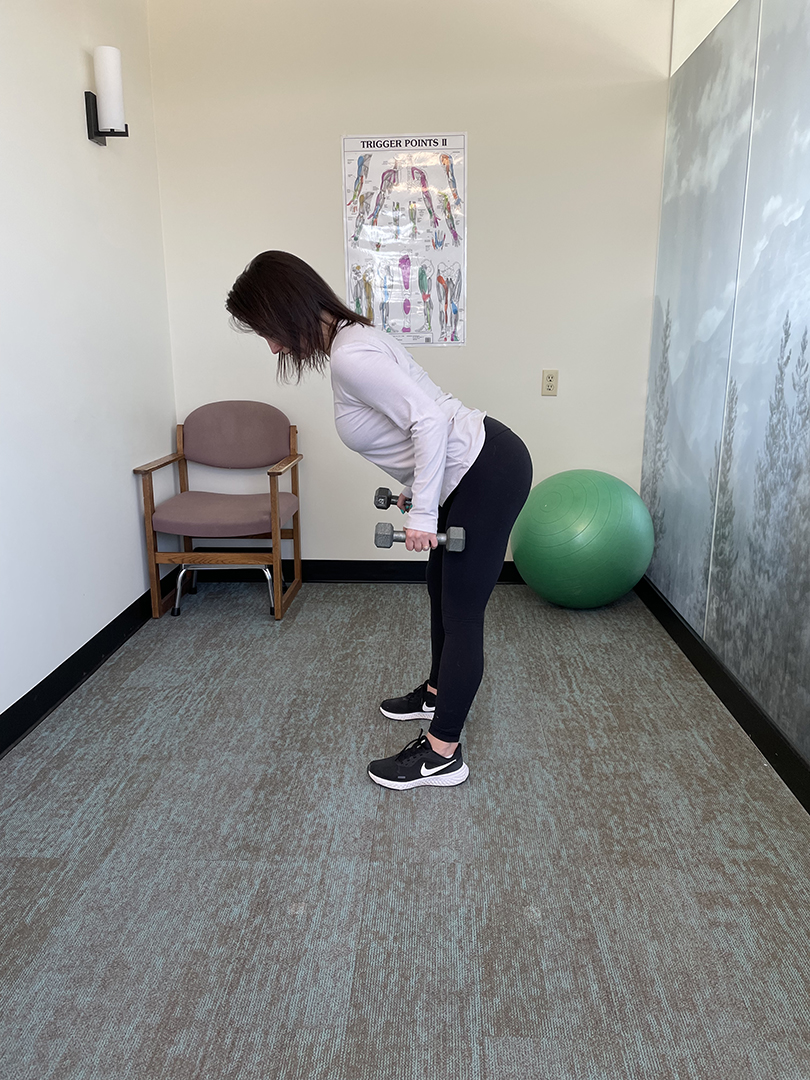
Scapular Prone Fly
Lie down on your stomach (prone position) with a pillow supporting your chest and a rolled-up towel under your forehead. Keep your arms by your sides, palms facing down, and your head aligned straight ahead. Draw your shoulder blades down and together. Once your shoulders are in the correct position, lift your arms about an inch off the ground while keeping your head on the towel.
Hold this position for 10-30 seconds, and repeat it five times. Aim to perform this exercise 1-2 times per day. Remember to maintain the shoulder blades down and back throughout the exercise. If you find it challenging to do so, stop the exercise and begin again to ensure proper form and alignment.
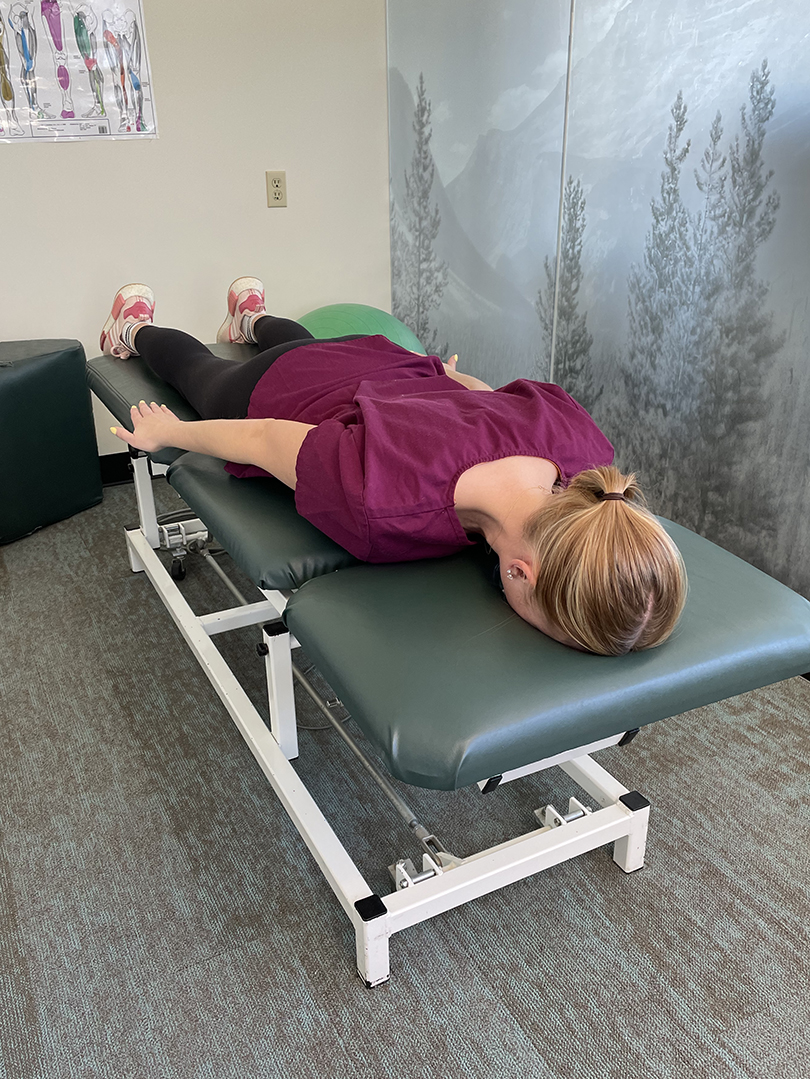
Squats
Stand with your feet slightly wider than shoulder-width apart. Toes should be pointing slightly outward, at around a 5- to 20-degree angle. Keep your chest up and your back straight, maintaining a neutral spine. Engage your core muscles to stabilize your torso. Begin the movement by pushing your hips back as if you are sitting down on an imaginary chair. This will help you maintain balance and keep your knees in line with your toes. As you push your hips back, bend your knees to lower your body toward the ground. Push through your heels and engage your leg muscles to lift yourself back up to the starting position.
Keep your chest up and your back straight, avoiding rounding your spine. Do 3 sets of 10 repetitions, 1-2 times per day. Start with bodyweight squats if you’re new to the exercise or have any mobility concerns. Once you feel comfortable and confident, you can add weights, such as dumbbells or a barbell.

6. Manage stress
To prevent neck pain it is also important to manage your stress; this can be through activities such as meditation, deep breathing, or physical activities like yoga or swimming or any activity that brings you joy and gives you energy. These activities can promote relaxation which can help to release tension in the neck muscles.
7. Schedule regular physio and massage
Regular physiotherapy can help prevent neck pain by addressing the underlying causes of the pain, such as poor posture, muscle imbalances or injuries. Our physiotherapists can develop a personalized plan to help strengthen the neck and surrounding muscles. Your plan may also include treatments such as manual therapy, joint mobilization, massages, and heat and ice therapy.
Most of the time, neck pain from sleeping wrong improves within a few days. A stiff neck usually lasts anywhere from one to three days, though it can take up to a week if the muscles are very tight. If your pain lasts longer than that, it’s worth checking in with your physiotherapist.
Do you need help relieving your neck pain?
Don’t let this pain continue to impact your daily routine and activities! If you have any questions about the different therapies and treatments we offer for neck pain, or if you have recently experienced a neck injury and need guidance on the best course of action, contact our clinic or book an appointment online.

